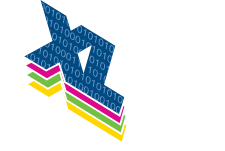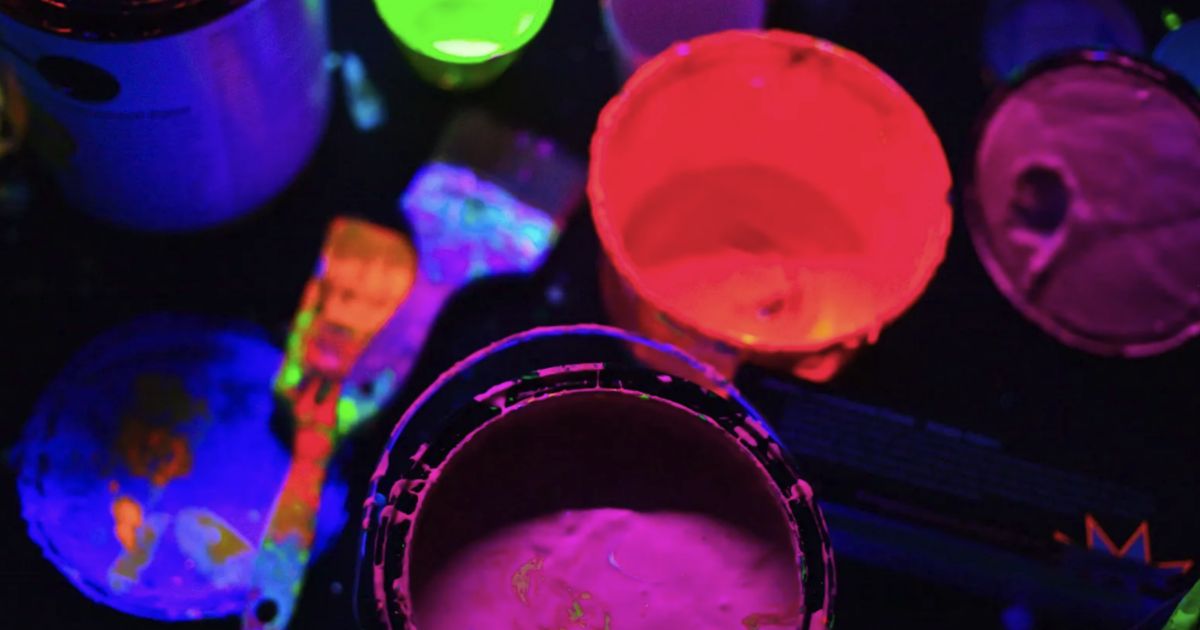The trade show floor is packed with hundreds of booths, each competing for attention with bright lights, bold colors, and creative displays. Yet one exhibit seems to pull visitors like a magnet, its graphics appearing to glow with an otherworldly vibrancy that makes everything else look dull by comparison. The secret isn’t just good design – it’s fluorescent ink technology that literally makes graphics shine brighter than the competition.
Most large format printing relies on standard CMYK color systems that, while capable of producing excellent results, are fundamentally limited by the physics of light reflection. Fluorescent inks operate on an entirely different principle, actually absorbing ultraviolet light and re-emitting it as visible light, creating colors that appear to glow from within.
How Fluorescent Ink Actually Works
Understanding fluorescent ink requires grasping a fundamental difference from conventional printing. Traditional inks work by absorbing certain wavelengths of light and reflecting others back to your eyes. A red ink absorbs green and blue wavelengths while reflecting red wavelengths, creating the color you perceive.
Fluorescent inks take this process further through fluorescence, a phenomenon where the ink absorbs invisible ultraviolet light and converts it into visible light. This means fluorescent graphics don’t just reflect existing light – they actually generate additional visible light, creating an intensity and vibrancy impossible with conventional inks.
This process explains why fluorescent graphics appear so dramatically different under various lighting conditions. In environments with significant UV content, such as outdoor daylight or certain indoor lighting systems, fluorescent graphics become dramatically more vibrant. The effect is so pronounced that fluorescent graphics often appear to glow even in normal lighting conditions.
The technology becomes particularly powerful when combined with fabric printing, where the textile substrate allows the fluorescent effect to penetrate through the material structure, creating graphics that seem to emit light from their entire surface rather than just reflecting it from the top layer.
Applications Where Fluorescent Ink Delivers Impact
Trade show environments represent the ideal application for fluorescent ink technology. Convention centers typically use lighting systems that contain UV components, activating the fluorescent properties and making displays dramatically more eye-catching than conventional graphics. When exhibitors need to capture attention in crowded environments, fluorescent graphics provide a competitive advantage that standard printing simply cannot match.
Retail environments benefit significantly from fluorescent graphics, particularly in stores with fluorescent or LED lighting systems that contain UV elements. Point-of-purchase displays printed with fluorescent inks draw customer attention more effectively than conventional alternatives, improving the effectiveness of promotional materials and seasonal campaigns.
Event signage and banners gain tremendous impact from fluorescent ink technology. Music festivals, sporting events, and outdoor gatherings often take place in environments where UV light levels are high, maximizing the fluorescent effect. Event organizers report that fluorescent banners and directional signage perform significantly better at capturing attention and improving wayfinding effectiveness.
Custom soft signage applications showcase fluorescent technology particularly well because fabric substrates allow the fluorescent effect to penetrate the material structure. This creates displays where the entire graphic surface appears to glow rather than just the printed surface, producing an immersive visual effect that’s impossible with rigid substrates.
The Technology Behind XL Digital’s Fluorescent Capability
XL Digital operates one of only two ATP 5-meter textile printers with fluorescent ink capability in North America, representing a significant technological advantage in the marketplace. This 16-foot-wide direct-to-fabric printer combines six standard colors with fluorescent inks, creating a color gamut that extends far beyond conventional printing limitations.
The integrated inline fixation system represents a crucial technological advancement, allowing the printer to complete the entire printing and finishing process in a single pass. Traditional fluorescent printing often requires separate heat treatment processes to properly cure the inks, adding time, complexity, and potential quality control issues. The integrated system eliminates these concerns while maintaining production efficiency.
The energy efficiency of this technology surprises many clients who assume that specialized fluorescent printing requires more power consumption. The ATP system actually uses less electricity than many smaller conventional printers while producing significantly more output, making fluorescent printing economically viable for large-scale projects.
The 6-color-plus-fluorescent ink configuration provides color matching capabilities that extend far beyond what’s possible with standard CMYK systems. This expanded color gamut allows for more accurate brand color reproduction while adding the fluorescent enhancement that makes graphics truly distinctive.
When to Choose Fluorescent Over Conventional Printing
Fluorescent ink technology delivers the greatest value in applications where capturing attention is the primary objective. Trade shows, retail promotions, event marketing, and any situation where your graphics compete directly with other visual elements benefit significantly from the enhanced visibility that fluorescent inks provide.
Consider fluorescent printing when your installation environment includes UV lighting components. Many modern LED systems, fluorescent fixtures, and certainly any outdoor applications contain enough UV content to activate fluorescent properties. The investment in fluorescent technology pays dividends in these environments through dramatically improved visibility and impact.
Budget considerations should factor in the total cost of attention capture rather than just printing costs. A fluorescent graphic that captures 30% more attention than a conventional alternative often provides better return on investment despite higher initial printing costs, particularly in high-stakes applications like trade shows or major retail promotions.
Brand guidelines may need consideration when planning fluorescent applications. Some brands have specific color standards that require conventional inks for perfect matching, while others benefit from the enhanced vibrancy that fluorescent inks provide. Discuss brand color requirements early in the planning process to ensure the final graphics meet both impact and compliance objectives.
Environmental and Practical Considerations
Fluorescent graphics maintain their enhanced visibility properties throughout their useful life, unlike some specialty effects that diminish over time. The fluorescent compounds remain stable under normal use conditions, ensuring that the investment in enhanced visibility continues paying dividends throughout the graphic’s lifespan.
Installation requirements for fluorescent graphics remain identical to conventional fabric graphics, requiring no special handling or mounting considerations. The enhanced visual impact comes from the ink technology rather than substrate or installation complexity, making fluorescent graphics a straightforward upgrade from conventional printing.
Storage and handling follow conventional guidelines, with fluorescent graphics packing, shipping, and storing exactly like traditional fabric prints. The technology enhancement doesn’t create additional logistical complexity or special handling requirements.
Measuring the Impact of Fluorescent Technology
Clients consistently report measurably improved performance from fluorescent graphics in attention-capture applications. Trade show exhibitors note increased booth traffic, retail installations report higher customer engagement, and event organizers observe improved wayfinding effectiveness when fluorescent graphics replace conventional alternatives.
The visual impact difference becomes immediately apparent when fluorescent and conventional graphics are installed side by side. The fluorescent graphics appear more vibrant, more eye-catching, and simply more present in the visual environment, creating a competitive advantage that translates directly into improved marketing effectiveness.
Return on investment calculations should consider both the initial printing cost difference and the performance improvement that fluorescent technology provides. In applications where capturing attention directly impacts business results, the enhanced performance often justifies the technology investment many times over.
At XL Digital, our ATP 5-meter fluorescent printing capability represents our commitment to providing cutting-edge solutions that deliver measurable business results. As one of only two companies in North America with this technology, we can offer clients a legitimate competitive advantage in markets where visual impact determines success. When your next project demands graphics that truly stand out, contact XL Digital to discover how fluorescent ink technology can make your message shine brighter than the competition.

